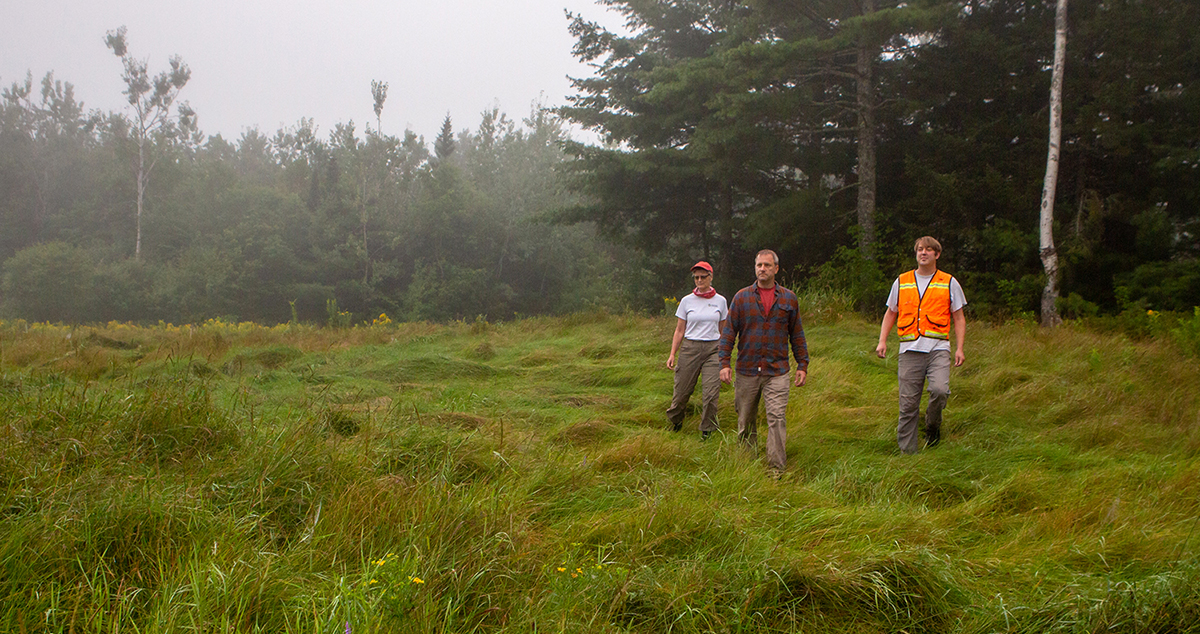Writing by NEFF Executive Director Bob Perschel and NEFF Communications Manager Tinsley Hunsdorfer
After years of developing, practicing and promoting forest-based solutions to climate change, New England Forestry Foundation (NEFF) is now perfectly positioned to take advantage of exciting, once in-a-lifetime opportunities like this year’s $1 billion USDA Partnerships for Climate-Smart Commodities Grant Program, which is to say, opportunities that will help us accomplish our 30 Percent Solution and sequester 646 million metric tons of CO2.
Note: NEFF received word September 14, 2022 that it had received a $30 million award from USDA. Click here for details.
Learn how NEFF built up its climate-mitigation programming and strategy to reach this point, and read about our next steps and hopes for the future.
The Intergovernmental Panel on Climate Change (IPCC) is the United Nations body assigned to steer the world away from the damaging consequences of climate change, and every several years, it releases updates on global climate change. The reports come in a series: the first covers the human contribution to the crisis, the second pinpoints the damage that is occurring, and the third and final report provides strategies for dealing with the problem.
This year, the IPCC rolled out its latest assessments. The first two were alarming—human-generated carbon pollution is still rising and the damage to the earth’s ecosystem is happening faster than we thought it would. The third report revealed for the first time what we at NEFF suspected 10 years ago: we can no longer meet our climate goals by reducing emissions, and now have to find ways to remove carbon from the atmosphere.
IPCC Climate Change 2022 Report: Mitigation of Climate Change
In their April 2022 Working Group III Climate Change Mitigation Report, the IPCC spotlights carbon removal as key to limiting warming to 2°C and states that forests lie at the center of how to do this. The IPCC identifies three main methods of carbon removal—and restoring forests through forest management practices along with utilizing sustainably produced wood to substitute for carbon-intensive building materials are identified as powerful nature-based carbon solutions.
The IPCC identified sustainably managed forests as a powerful existing and immediate opportunity to remove carbon from the atmosphere. The climate spotlight is turning to forests and forest management, and NEFF is ready thanks to the work we started 10 years ago to investigate forests and climate change, and develop a pathway for forestry to be helpful. The result is our 30 Percent Solution: The combined climate-mitigating impact of expanding the practice of Exemplary Forestry, halting forest conversion, and building with wood amounts to 30 percent of New England’s necessary energy-related carbon reductions in the next 30 years.
What We’ve Done, Where We’re Going
Here’s a timeline of our work leading right up to—and briefly looking beyond—the possibilities presented by the 2022 $1 billion USDA grant program, which will fund pilot projects that create market opportunities for commodities produced using climate-smart practices. We’ve broken down projects and accomplishments by the five NEFF program areas that support the 30 Percent Solution: Science, Policy, Outreach and Coalition Building, Communications, and Innovative Conservation Finance.
2012
Outreach and Coalition Building: Harvard Forest began developing its Wildlands and Woodlands vision in 2005, with an assessment of forest loss and the pace of conservation in Massachusetts. In 2010, the vision went region-wide and identified the need to ramp up the pace of conservation to protect forests’ benefits to New England residents. The NEFF Board of Directors formally endorses the Wildlands and Woodlands vision in 2012.
2013
Science, Communications: NEFF releases The Path to Sustainability, a fully researched report about New England forests’ existing contributions and future potential to support New Englanders’ lives and lifestyles, and it lays out 12 of these current and future benefits as well as pathways to protect them and the sustainable future they represent. In compiling the report, NEFF concludes the connection between forests and climate change could potentially yield extraordinary climate-mitigation benefits—it is clearly the most important and immediate societal benefit of forests. NEFF’s strategic direction is set.
Outreach and Coalition Building: There are more than 215,000 forest owners of more than 10 acres in New England and the ability of our forests to respond to climate change depends on them. The conservation community needed a more effective and efficient way of reaching these landowners and working with them to change practices. In response, NEFF and partners launch the MassConn Woods Landowner Outreach Initiative in 2013 to learn how to perform more effective outreach by developing and testing a replicable model for engaging, educating, and supporting family forest landowners to embrace the values of better forest management and large-scale land protection. Learn more.
2014
Science, Outreach and Coalition Building: NEFF joins the nascent Maine Mountain Collaborative to bring forest management expertise to an ongoing partnership that uses cross-sector collaboration and innovative financing to accelerate the pace and scale of land conservation in the Maine Appalachian Corridor. This relationship allows NEFF to understand the biodiversity goals of the conservation community and the financial management goals of large commercial landowners in order to construct climate-smart forestry practices that serve both.

NEFF works with the Maine Mountain Collaborative to protect and bring forest management expertise to the Maine Appalachian Corridor, also called the Mountains of the Dawn
2015
Science: NEFF identifies consistent, scientific and transparent forest management standards as the missing ingredient in efforts to determine the magnitude of sustainable forestry’s climate benefit, as well as in efforts to align forest landowners with the goal of increasing in-forest carbon sequestration. NEFF commits to codifying our in-house forest practices and calls together an expert panel to advise us on the development of Exemplary Forestry standards.
2016
Innovative Conservation Finance: Working with our Wildlands and Woodlands partners, NEFF staff determines that two types of new, targeted programs and financing models are needed to increase the pace of conservation and bring more land under Exemplary Forest management: one that could serve southern New England’s smaller landholdings, and one for the large, northern commercial landholdings. We begin investigating and developing two new funds that would later launch as the Pooled Timber Income Fund and Exemplary Forestry Investment Fund.
Science, Outreach and Coalition Building: We extend our climate-mitigation analysis beyond the forest to investigate the impact of forest products, and uncover an additional mitigation pathway that expands forests’ overall climate benefits: sustainably harvest wood grown locally under climate-smart management, make engineered mass timber with it, and then use the mass timber locally in long-lived products like tall buildings. NEFF launches the Build It With Wood program to advocate for building tall urban structures with mass timber to mitigate climate change, build rural economic opportunity, and improve housing quality and equity.

Common Ground High School, a mass timber building, New Haven, CT, Gray Organschi Architecture. Photo by David Sundberg ESTO.
2017
Innovative Conservation Finance: NEFF and the Maine Mountain Collaborative partner to begin the formal creation of the Exemplary Forestry Investment Fund, designed to utilize private equity investments to buy large parcels of Maine timberland—and to compete with other investment interests—and manage them for climate benefits under Exemplary Forestry. Boston law firm Ropes and Gray assists with the financing arrangement’s complex structure by providing pro bono advice.
Outreach and Coalition Building: NEFF is awarded a multi-year U.S. Forest Service grant to develop outreach messaging about climate change for the MassConn landowner audience and train professional foresters to provide advice on forest climate resilience at the property level.
2018
Science: NEFF releases Exemplary Forestry standards for the Acadian Forest, and the standards’ specific and measurable practices make it possible for NEFF to model the climate impact of Exemplary Forestry being implemented across the landscape. The results are astounding: New England could sequester 540 million metric tons of CO2 by expanding Exemplary Forestry.

NEFF staff members walk through Frenchman Bay Community Forest, where NEFF is implementing Exemplary Forestry in support of songbird populations. Photo by Lauren Owens Lambert
2019
Outreach and Coalition Building: NEFF utilizes a federal grant to launch the Western Maine Habitat Restoration initiative with organizational partners. NEFF staff engages in strategic outreach to family forestland owners and helps those who enroll to create or restore important wildlife habitat on 12,000 acres of privately owned forest using Exemplary Forestry.
Innovative Conservation Finance: NEFF launches the Pooled Timber Income Fund (PTIF). Participants donate their woodlands to NEFF, and the woodlands’ timber is then contributed to a pooled income fund trust. Donors receive a stream of lifetime income and an initial charitable tax deduction, and on the death of their beneficiaries, the timber reverts to NEFF. Three properties—with a fourth in the works—and 1,740 acres have now been donated to NEFF through the PTIF, two individuals have donated cash directly into the PTIF, and an additional two properties have been leased from The Nature Conservancy. All donated properties join NEFF’s network of Community Forests and receive Exemplary Forestry management, which helps us demonstrate climate-smart forestry in new communities.
Communications: The New York Times runs a NEFF op-ed in both print and digital editions that touts Exemplary Forestry and locally sourced mass timber as pathways to a better future and more livable climate.
Communications, Outreach and Coalition Building: After years of hard and innovative work, we publish “From Engagement to Action: Supporting Woodland Owners in Decisions About Their Land”—a report on NEFF’s MassConn landowner-outreach successes and lessons learned from communicating about climate change with landowners in preparation for expanding use of the program’s outreach format.
2020
Communications: NEFF’s Exemplary Forestry program receives global attention on Prince Charles’ RE:TV video platform, which showcases inspiring sustainability innovation from around the world. The website launches with a feature video (also embedded below) about NEFF and Exemplary Forestry on the homepage.
Policy: To help state governments meet their climate goals by using forests to help mitigate climate change, NEFF becomes actively involved with both the Maine Climate Council (MCC) and the companion effort in Connecticut, the Governor’s Council on Climate Change (GC3), and when appropriate, brings Exemplary Forestry to the table as an example of a workable model for climate-smart forestry and a potential path forward.
Science: NEFF expands its climate-mitigation modeling research to all of New England, and examines how and to what degree forests in each New England state could be managed to contribute to climate change mitigation. Our science team determines NEFF’s forest-based climate-mitigation approach can meet 30 percent of those reduction goals, and the term “30 Percent Solution” is born.
Outreach and Coalition Building: We launch our Forest-to-Cities Climate Challenge program, the public engagement partner to our Build It With Wood initiative. The Challenge works to help reduce the climate crisis and create a more liveable New England by supporting sustainable wood construction. We build a broad network of experts and supporters—including architects, builders, foresters, forest owners, and others—who commit to this vision by signing our Climate Challenge Pledge, and we provide them with ways to take action and make a difference by working collaboratively across different sectors.
2021
Innovative Conservation Finance: NEFF helps form and participates in the Forest Carbon for Commercial Landowners dialogue, which then creates and funds a project team of scientists and policy experts tasked with determining which practices might improve carbon storage on large forest ownerships and how to pay for those practices.
Communications: NEFF is featured on an episode of Chronicle, a Boston-based TV show, that focuses on our own Exemplary Forestry standards, forestry and recreation in the Maine North Woods, and how sustainable local wood can be used in urban tall wood buildings. See clips from the show in a July 2021 NEFF blog post.
2022
Science: We release our second set of Exemplary Forestry standards, this time for Central and Transition Hardwoods forests.

The Scarlet Tanager is an umbrella species for NEFF’s new Central and Transition Hardwood Exemplary Forestry standards.
Policy: The U.S. Department of Agriculture offers a $1 billion Partnerships for Climate-Smart Commodities grant opportunity, and NEFF responds with a $38 million proposal to provide incentives to family and commercial forest landowners, loggers and foresters to sequester significant amounts of carbon through improved forest management and to support mass timber building.
Innovative Conservation Finance: NEFF and partners launch the Exemplary Forestry Investment Fund to purchase and manage large forest tracts in Maine. NEFF chairs the Fund’s Board of Directors and the Fund targets a first property purchase near Moosehead Lake.
2023 and Beyond
Now that our analysis shows the major role forestry can play in mitigating climate change and improving biodiversity, NEFF has reached a moment of tremendous opportunity for New England’s forests, and the IPCC reports signal it is past time for action. The pathway forward calls for targeted financial incentives for landowners to implement climate-smart practices on their forests, and programs that verify these practices are working. The USDA grant opportunity may provide New England with a significant pilot program, but NEFF’s job is to ensure long-term funding is available to complete the job.
This is an exciting time: we can accomplish NEFF’s foundational mission of bringing Exemplary Forestry to New England while we help solve a major part of the climate mitigation burden.
